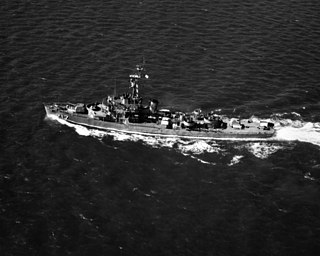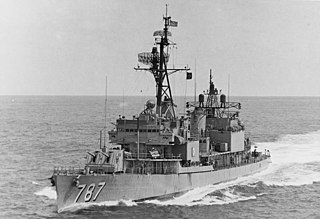
USS Badoeng Strait (CVE-116) was a Commencement Bay-class escort carrier of the United States Navy during the Korean War.

USS Arnold J. Isbell (DD-869), a Gearing-class destroyer, was the only ship of the United States Navy to be named for Arnold J. Isbell, an aircraft carrier captain during World War II. The ship was laid down on 14 March 1945 at Staten Island, New York, by Bethlehem Mariners Harbor, launched on 6 August 1945 and commissioned on 5 January 1946. Constructed too late to see action in World War II, the vessel initially served as a training ship with the United States Atlantic Fleet, before transferring to the Pacific and deploying to Korea during the Korean War and off the Vietnam coast during the Vietnam War. In 1972 Arnold J. Isbell was made part of the reserve training fleet and in 1974, sold to Greece where the ship was renamed Satchouris and served with the Hellenic Navy until being sold for scrap in 2002.

USS Sicily (CVE-118) was a Commencement Bay-class escort carrier in the United States Navy. She was named in honor of the island of Sicily, which was the site of a major invasion during World War II. Sicily was laid down on 23 October 1944 by Todd-Pacific Shipyards, Tacoma, Washington, as Sandy Bay; launched on 14 April 1945; sponsored by Mrs. Julius Vanderwiele; renamed Sicily on 5 June 1945; and commissioned on 27 February 1946, Capt. B. W. Wright in command.

USS Newman K. Perry (DD-883/DDR-883), was a Gearing-class destroyer of the United States Navy.

USS Gilbert Islands (CVE-107) was a Commencement Bay-class escort carrier of the United States Navy.

USS Vermillion Bay (CVE-108) was an Commencement Bay-class escort carrier of the United States Navy. She was renamed Kula Gulf on 6 November 1943; laid down by Todd-Pacific Shipyards, Inc., Tacoma, Wash. on 16 December 1943; launched on 15 August 1944; sponsored by Miss Dorothy Mott; completed by Willamette Iron & Steel Corp., Portland, Oregon; and commissioned at Portland on 12 May 1945, Captain J. W. King in command.

USS Salerno Bay (CVE-110) was a Commencement Bay-class escort carrier laid down on 7 February 1944 by Seattle-Tacoma Shipbuilding Corporation, Tacoma, Washington; launched on 26 September 1944; sponsored by Mrs. Ward Gilbert; transferred to the Commercial Iron Works, Portland, Oregon, for completion on 29 September 1944; and commissioned on 19 May 1945, Captain W. C. Holt in command.

USS Perkins (DD/DDR-877) was a Gearing-class destroyer in the United States Navy. She was the third Navy ship named for Commodore George H. Perkins USN (1835–1899).

USS Merrill (DD-976), named for Rear Admiral Aaron Stanton Merrill USN (1890–1961), was a Spruance-class destroyer that entered service with the United States Navy in 1978. Merrill served as the US Navy's test platform for the Tomahawk cruise missile. In the 1980s, the destroyer took part in Operation Earnest Will in the Persian Gulf during heightened tensions with Iran. The destroyer was decommissioned in 1998. The vessel was used as a target ship in 2003 and sunk off Hawaii in 2003.

USS Remey (DD-688) was a Fletcher-class destroyer of the United States Navy, named for Rear Admiral George C. Remey (1841–1928).

USS Preston (DD-795), a Fletcher-class destroyer, was the sixth ship of the United States Navy to be named for Lieutenant Samuel W. Preston (1840–1865).

The fourth USS Preble (DD-345/DM-20/AG-99) was a Clemson-class destroyer in the United States Navy following World War I, and saw combat in World War II as a minelayer. She was named for Commodore Edward Preble.

USS Coolbaugh (DE-217) was a Buckley-class destroyer escort in service with the United States Navy from 1943 to 1960. She was scrapped in 1973.

USS Rupertus (DD-851) was a Gearing-class destroyer of the United States Navy, named for United States Marine Corps Major General William H. Rupertus (1889–1945).

USS Richard B. Anderson (DD-786) was a Gearing-class destroyer of the United States Navy, named for USMC Private First Class Richard B. Anderson (1921–1944), who was posthumously awarded the Medal of Honor for heroism during the Battle of Kwajalein.

USS James E. Kyes (DD-787) was a Gearing-class destroyer of the United States Navy, named for Commander James E. Kyes (1906–1943).

USS Ernest G. Small (DD/DDR-838) was a Gearing-class destroyer of the United States Navy, named for Rear Admiral Ernest G. Small (1888–1944).

USS Tills (DE-748) was a Cannon-class destroyer escort in service with the United States Navy from 1944 to 1946 and from 1950 to 1968. She was sunk as a target in 1969.

USS Hillsborough County (LST-827) was an LST-542-class tank landing ship built for the United States Navy during World War II. Named after Hillsborough County, Florida, she was the only U.S. Naval vessel to bear the name.






















